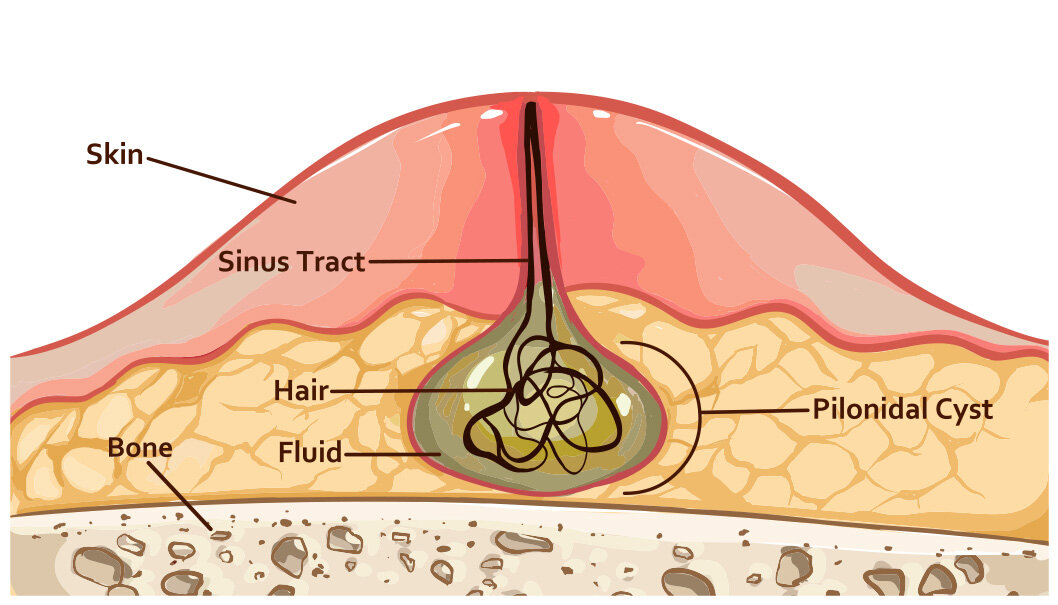Pilonidal Sinus Treatments
What is pilonidal sinus disease?
A pilonidal sinus is a small hole or tunnel in the skin inside your natal cleft (the area between your buttocks) which can get infected and form an abscess. These sinuses are often caused by hairs that grow in your natal cleft, or loose hairs that fall and collect in your natal cleft. Pilonidal sinus disease is a painful condition that can become recurrent or chronic without surgical therapy.
Can you treat pilonidal sinus without surgery?
Treatment for an infected pilonidal sinus depends on the severity of your pain and other symptoms, the size of the sinus and whether it's your first infection or if it keeps recurring. The treatments for pilonidal sinus include:
Hygiene and hair removal – washing your natal cleft every day may help to prevent a build up of hairs and subsequent infection of the area. Regular removal of hair from the area by waxing may also make a difference
Medications – the first line of treatment is to settle a mild acute infection may be antibiotics.
Abscess treatment – whilst small abscesses may be lanced by your GP or in the emergency department, they commonly then recur and assessment by a surgeon is recommended even for small abscesses. A surgical drainage with or without removal of any visible sinuses may reduce the chance of future problems
Surgical management - once any infection has settled, you can plan for a longer-term solution to manage recurrent and painful sinuses by having it surgically removed. There are a number of surgical techniques available for this
What is the surgical treatment of pilonidal sinus?
Pilonidal sinus surgery removes the sinus and infected tissue and is performed under a general anaesthetic. The goal is to remove any pockets of infection and prevent reinfection by removing the sinus and ensuring the skin heals completely.
There are different techniques used to treat pilonidal sinus disease depending on the size and location of the sinuses. The most common procedures include:
Surgical excision with or without closure of skin – this surgery involves removing all sinus tracts and using a flap of skin to achieve wound closure (either a Karydakis flap or rhomboid flap) and flatten out the area between the buttocks to reduce the rates of recurrence.
Endoscopic ablation – a less invasive procedure involves using an endoscope to clean and remove any hairs from within the sinus tracts, and using heat (ablation) to seal the sinus.
Dr Ghadiri will discuss the most suitable options with you at your consultation.
How long is the recovery after pilonidal sinus surgery?
The recovery time for pilonidal sinus surgery varies depending on the procedure:
Recovery times for surgical excision:
Usually performed under general anaesthetic with an overnight stay
Stitches are removed after around 10 days
Quicker recovery with healing time usually around 2-3 weeks
Higher risk of infection of wound (dressings will need to be changed regularly)
Recovery time for endoscopic ablation:
Usually performed under general anaesthetic as an outpatient (you can go home the same day)
Heat is used to seal the sinus so no stitches are used but the area will be dressed
Recovery time is about one month to heal completely
Low risk of complications but healing may take longer
You will need to follow Dr Ghadiri’s post-operative care instructions carefully regarding your return to work or exercise. A pilonidal sinus may come back. Dr Ghadiri will suggest ways to reduce the chance of recurrence.
Where will my surgery be performed?
Dr Ghadiri performs pilonidal sinus surgery in Brisbane at Brisbane Private Hospital (Wickham Tce) and the Wesley Hospital. She also performs surgery in Ipswich at St Andrew’s Private Hospital.

